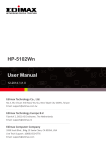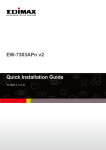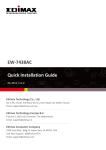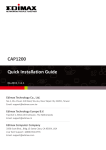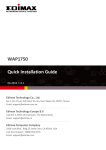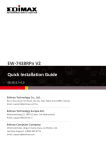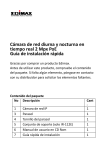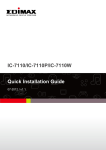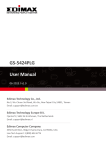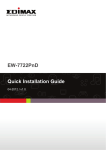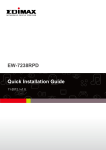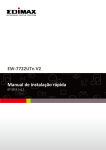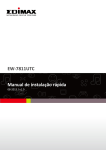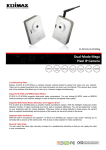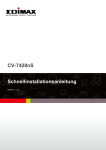Download HP-5102Wn User Manual
Transcript
HP-5102Wn User Manual 12-2014 / v1.0 COPYRIGHT Copyright Edimax Technology Co., Ltd. all rights reserved. No part of this publication may be reproduced, transmitted, transcribed, stored in a retrieval system, or translated into any language or computer language, in any form or by any means, electronic, mechanical, magnetic, optical, chemical, manual or otherwise, without the prior written permission from Edimax Technology Co., Ltd. Edimax Technology Co., Ltd. makes no representations or warranties, either expressed or implied, with respect to the contents hereof and specifically disclaims any warranties, merchantability, or fitness for any particular purpose. Any software described in this manual is sold or licensed as is. Should the programs prove defective following their purchase, the buyer (and not this company, its distributor, or its dealer) assumes the entire cost of all necessary servicing, repair, and any incidental or consequential damages resulting from any defect in the software. Edimax Technology Co., Ltd. reserves the right to revise this publication and to make changes from time to time in the contents hereof without the obligation to notify any person of such revision or changes. The product you have purchased and the setup screen may appear slightly different from those shown in this QIG. For more information about this product, please refer to the user manual on the CD-ROM. The software and specifications are subject to change without notice. Please visit our website www.edimax.com for updates. All brand and product names mentioned in this manual are trademarks and/or registered trademarks of their respective holders. Edimax Technology Co., Ltd. Add: No. 3, Wu-Chuan 3rd Rd., Wu-Ku Industrial Park, New Taipei City, Taiwan Tel: +886-2-77396888 Email: [email protected] Notice According to GNU General Public License Version 2 This product includes software that is subject to the GNU General Public License version 2. The program is free software and distributed without any warranty of the author. We offer, valid for at least three years, to give you, for a charge no more than the costs of physically performing source distribution, a complete machine-readable copy of the corresponding source code. CONTENTS I. PRODUCT INFORMATION ............................................................................................................. 1 I-1. Package Contents ......................................................................................................................1 I-2. Hardware ...................................................................................................................................2 I-3. LED Status ..................................................................................................................................3 I-4. Resetting the Powerline Adapter ..............................................................................................4 I-5. Safety Information .....................................................................................................................5 II. POWERLINE NETWORK ................................................................................................................ 6 II-1. Installation .................................................................................................................................6 II-2. Leaving a Powerline Network ....................................................................................................8 II-3. WPS Setup .................................................................................................................................9 III. WI-FI CONFIGURATION .............................................................................................................. 10 III-1. Setup Wizard ..........................................................................................................................12 III-2. III-3. III-4. Device Configuration ..............................................................................................................13 WLAN Configuration ...............................................................................................................14 Status Overview ......................................................................................................................16 III-5. Management ..........................................................................................................................17 III-5-1. Account ............................................................................................................................18 III-5-2. DHCP Server .....................................................................................................................19 III-5-3. Factory Restore ................................................................................................................20 III-5-4. WLAN Radio Configuration ..............................................................................................21 IV. POWERLINE UTILITY SOFTWARE ................................................................................................ 23 IV-1. Using the Utility ......................................................................................................................24 IV-1-1. Main .................................................................................................................................24 V. IV-1-2. Diagnostics .......................................................................................................................26 IV-1-3. About ................................................................................................................................ 27 APPENDIX ................................................................................................................................. 28 V-1. Windows XP.............................................................................................................................28 V-2. Windows Vista.........................................................................................................................29 V-3. Windows 7 ...............................................................................................................................30 V-4. Windows 8/8.1 .........................................................................................................................32 V-5. Mac OS.....................................................................................................................................36 V-6. Glossary ...................................................................................................................................38 I. PRODUCT INFORMATION I-1. Package Contents Before you start using this product, please check if there is anything missing in the package, and contact your dealer to claim the missing items(s): HP-5102Wn Ethernet Cable CD-ROM 1 Quick Installation Guide I-2. 1 2 3 4 Hardware LEDs See I-3. LED Status below. Press for 10+ seconds to reset the HP-5102Wn Powerline function (PLC utility settings) to factory defaults, and less Reset/Group 3 seconds to connect with another Powerline adapter. Button Press for 5 - 8 seconds to leave an encrypted powerline network group. Press for 10+ seconds to reset the Wi-Fi functions (web WPS Button U.I. settings) to factory defaults and less than 2 seconds to activate WPS (see II-3. WPS Setup). Connect a computer or Ethernet device to the Ethernet Port HP-5102Wn. 5 On/Off Switch Switch the HP-5102Wn on or off. 2 I-3. LED Status LED Color LED Status On Power Green Flashing Off On Flashing Green PLC Off Orange Flashing Red Flashing On LAN Green Wi-Fi Green Flashing Description HP-5102Wn is on. Establishing Powerline connection. HP-5102Wn is off. Powerline connection detected. Powerline traffic: excellent connection. No Powerline connection detected. Powerline traffic: good connection. Powerline connection: bad connection. LAN port connected. LAN activity (transferring or receiving data). Off LAN port not connected. On WPS is active. Wireless activity (transmitting or receiving data). No wireless activity. Flashing Off 3 I-4. Resetting the Powerline Adapter If you experience a problem with your HP-5102Wn you can reset the device back to its factory default settings. To reset Powerline settings, press and hold the Reset/Group button for at least 10 seconds. The power LED ( ) will display on when the HP-5102Wn is ready (see LED Status). To reset Wi-Fi settings, press and hold the WPS button for 10+ seconds. 4 I-5. Safety Information In order to ensure the safe operation of the device and its users, please read and act in accordance with the following safety instructions. 1. The powerline adapter is designed for indoor use only; do not place the powerline adapter outdoors. 2. Do not place the powerline adapter in or near hot/humid places, such as a kitchen or bathroom. 3. Do not pull any connected cable with force; carefully disconnect it from the powerline adapter. 5. The device contains small parts which are a danger to small children under 3 years old. Please keep the powerline adapter out of reach of children. 6. Do not place the powerline adapter on paper, cloth, or other flammable materials. The powerline adapter will become hot during use. 7. There are no user-serviceable parts inside the powerline adapter. If you experience problems with the powerline adapter, please contact your dealer of purchase and ask for help. 8. The powerline adapter is an electrical device and as such, if it becomes wet for any reason, do not attempt to touch it without switching the power supply off. Contact an experienced electrical technician for further help. 5 II. POWERLINE NETWORK A minimum of two Powerline devices are required to establish a Powerline network. For best performance, plug Powerline adapters directly into standard wall sockets. Avoid using multi-socket adapters. It may be convenient to install and configure your Powerline adapters in the same room, and then relocate the HP-5102Wn to its preferred location after setup is complete. II-1. Installation 1. Connect a Powerline adapter to your router via Ethernet cable and plug it into a power socket. The power and LAN LEDs should display on. 2. Plug the HP-5102Wn into a power socket, and confirm the power LED is on. 3. The PLC LED on both Powerline adapters should indicate that a Powerline connection is established. For the HP-5102Wn the PLC LED will display on (see LED Status). 6 4. If you want to create a private network, press the “Reset/Group” button on each Powerline adapter for less than 3 seconds, within 2 minutes of each other. The adapters will automatically group together and generate an encrypted network. 5. To connect to your HP-5102Wn’s Wi-Fi, use a Wi-Fi device (e.g. computer, tablet, smartphone) to search for a Wi-Fi network with the SSID “EdimaxPLC_***” and connect to it. The password is displayed on the product label. Note: The last three characters of the SSID are unique to your device. The full SSID & password is displayed on the product label as shown below. Note: Alternatively, you can use the WPS button as described later in II-3. WPS Setup. 7 6. You can also use an Ethernet cable to connect a computer or other device to the HP-5102Wn using the Ethernet port on the underside of the product. II-2. Leaving a Powerline Network Press the “Reset/Group” button on the powerline adapter for 5–8 seconds to leave a Powerline network that the HP-5102Wn is connected to. The HP-5102Wn will be disconnected/ungrouped from its network and ready to reconnect to any Powerline network. 8 II-3. WPS Setup If your wireless device supports WPS (Wi-Fi Protected Setup) then you can use this method to connect to the HP-5102Wn’s Wi-Fi after you have established a Powerline connection. 1. Press the WPS button on the HP-5102Wn for less than 2 seconds to activate WPS. The HP-5102Wn’s Wi-Fi LED will display on to indicate that WPS is active. 2. Within two minutes, press the WPS button on your wireless device to activate WPS. The devices will establish a connection. Note: Please check the instructions for your wireless device for how long you need to hold down its WPS button to activate WPS. 9 III. WI-FI CONFIGURATION To make configurations to your HP-5102Wn (e.g. change the SSID & password) you can use the product’s web-based control panel. To access the control panel, follow the instructions below: Note: By default, the HP-5102Wn is set to use a dynamic IP address from your router. This means that order to access the control panel as shown here using the default IP address, the HP-5102Wn must be disconnected from your router. If using a dynamic IP or if you later set your powerline adapter to use a static IP address – then you do not need to disconnect the HP-5102Wn from your router to access the control panel. In such cases, use the new IP address to access control panel instead. 1. Connect your computer to the HP-5102Wn using Wi-Fi (Default SSID: EdimaxPLC_*** see product label) or using an Ethernet cable as shown below: 2. Change your computer’s IP address to 192.168.2.x where x = any number between 3 and 254. Refer to the appendix if you need help. 10 Note: If you later change your HP-5102Wn’s IP address then please adjust this step to ensure your computer’s IP address is in the same subnet. 3. Go to 192.168.2.2 in a web browser and you will arrive at the login screen, as shown below. The default username is admin and the default password is 1234. Note: If you cannot access the control panel, please unplug your HP-5102Wn and plug it back in, and try again. 11 III-1. Setup Wizard Click “Start Setup Wizard” to set the SSID and password of the powerline adapter. Name (SSID) Password Enter the network name(SSID) name for the Wi-Fi network. The SSID can consist of any combination of up to 32 alphanumeric characters. Enter a password of 8 – 63 characters for the SSID. 12 III-2. Device Configuration Select “DHCP” for your powerline adapter to be assigned a dynamic IP address from your router’s DHCP server, or select “Fixed IP” to manually specify a static/fixed IP address for your powerline adapter. When using “DHCP” check your router’s settings to find your powerline adapter’s IP address. Fixed IP IP Address Subnet Mask Specify a static IP address here. This IP address will be assigned to your powerline adapter and will replace the default IP address. Specify a subnet mask. The default value is 255.255.255.0 Note: If you assign a new IP address to your powerline adapter, use this IP address in a web browser to access the control panel, and ensure your computer’s IP address is in the same subnet. 13 III-3. WLAN Configuration The powerline adapter provides three security/encryption options. When data is encrypted, information transmitted wirelessly cannot be read by anyone who does not know the correct encryption key. By default, WPA encryption is enabled. It’s essential to configure wireless security in order to prevent unauthorised access to your network. Select hard-to-guess passwords which include combinations of numbers, letters and symbols, and change your password regularly. 14 Name (SSID) Channel Security Settings Open WEP WPA Enter the network name (SSID) for the Wi-Fi network. The SSID can consist of any combination of up to 32 alphanumeric characters. Select a radio channel for your Wi-Fi or use the auto setting. Selecting a less-crowded channel can improve performance due to less interference from other Wi-Fi devices. See below for information about country-specific restrictions. Channels 1-11 approved for use in the United States, Canada, Latin America, and Taiwan. Channels 1-14 approved for use in Japan. Channels 1-13 approved for use in other countries. Authentication is disabled and no password/key is required to connect to the powerline adapter. Not recommended. WEP (Wired Equivalent Privacy) is a basic encryption type. Enter a security key. For a higher level of security consider using WPA encryption below. WPA is a secure wireless encryption type with strong data protection and user authentication, utilizing 128-bit encryption keys. Select from WPA, WPA2 or both. WPA2 is safer than WPA only, but not supported by all wireless clients. Selecting both will use WPA2 where supported by clients. Please make sure your wireless client supports your selection. Enter your security key. 15 III-4. Status Overview Displays the current firmware version and the MAC address of any wireless clients which are connected to the powerline adapter. 16 III-5. Management The sub-menu provides access to various management settings: 17 III-5-1. Account Account settings are the username and password used to log in to the control panel. The default values are username: admin password: 1234. It is recommended to change account settings according to your preference. 18 III-5-2. DHCP Server Enable or disable the powerline adapters DHCP server. The DHCP server will automatically assign an IP address to network devices connected to the powerline adapter. You can specify a range of IP address to assign. Do not enable DHCP server is your router has also enabled DHCP server. First IP Address Last IP Address Enter the start IP address for the DHCP server’s IP address leases. Enter the end IP address for the DHCP server’s IP address leases. 19 III-5-3. Factory Restore You can restore the powerline adapter back its factory default state. This resets all settings including SSID, password and IP settings. 20 III-5-4. WLAN Radio Configuration You can configure the powerline adapter’s Wi-Fi radio. Name (SSID) Channel Mode Enter the network name (SSID) for the Wi-Fi network. The SSID can consist of any combination of up to 32 alphanumeric characters. Select a radio channel for your Wi-Fi or use the auto setting. Selecting a less-crowded channel can improve performance due to less interference from other Wi-Fi devices. See below for information about country-specific restrictions. Channels 1-11 approved for use in the United States, Canada, Latin America, and Taiwan. Channels 1-14 approved for use in Japan. Channels 1-13 approved for use in other countries. Select the wireless standard used for the powerline adapter from 802.11g & 802.11n. 21 Channel Width Select wireless channel width (bandwidth used by wireless signals from the device) – the recommended value is HT20/40. 22 IV. POWERLINE UTILITY SOFTWARE The included CD-ROM contains Powerline utility software which provides powerline diagnostic information and management for advanced users. Before installating the utility software, please uninstall any existing Powerline utility software you may already have. To install the utility software, insert the CD into your CD-ROM drive and the setup wizard should begin automatically. If not, please manually locate and open the “AutoRun.exe” file in the CD. 1. When the following screen appears, select your model. 2. Click “Setup Utility” and follow the on-screen instructions. 23 IV-1. Using the Utility The following pages describe the functions of each tab within the Powerline utility software. IV-1-1. Main The “Main” tab provides a list of Powerline adapters connected to the network. Use the drop down menu to select a network card if you have more than one installed on your computer. 24 Name MAC Address Password This column shows the default device name, for example: “Device 2”, “Device 3”. If you want to change the name, please click “Set Name” button to edit the name. The adapter’s MAC address will be shown here. This column by default is blank. In order to manage the powerline adapters, you have to enter the password of the adapter. The password is printed on the label located on the back of the powerline adapter. After you have entered the correct password, this column will show the password. To set the password of the adapter, first select the adapter by clicking on its name and then click “Enter Password” button. A dialog box will appear as below. Please type the password and click “OK” button. Quality Speed (Mbps) Set Name Enter Password Scan The status of the connection quality will be shown here. Shows the current data rate of the powerline adapter. Select a device and click “Set Name” to rename the device. Click “Enter Password” to set up a password for the selected device. Perform a scan of other remote Powerline adapters. By default, the utility automatically scans every few seconds. 25 Security Network Name Set All Remote Devices Whose Password Has Been Entered Set Local Devices IV-1-2. Powerline adapters often ship with the same default network name “HomePlugAV”. Powerline adapters with the same network name can be connected together. If you want to create another network, please enter the new network name and select “Set all remote devices whose password has been entered” or “Set Local Device Only” below. Change the network name of all devices that appear in box above whose password has been entered. Change the network name for local devices only. Diagnostics The “Diagnostics” tab displays the system information and history of all remote devices. The upper panel displays technical data concerning the software and hardware on the host computer and the lower panel displays the history of all remote devices. Click “Save Report” to save the report to local storage. 26 IV-1-3. About The “About” tab displays basic information about the software. 27 V. APPENDIX How to Modify the IP Address of Your PC or Mac Please follow the instructions appropriate for your operating system. In the following examples we use the IP address 192.168.2.10. V-1. Windows XP 1. Click the “Start” button (it should be located in the lower-left corner of your computer), then click “Control Panel”. Double-click the “Network and Internet Connections” icon, click “Network Connections”, and then double-click “Local Area Connection”. The “Local Area Connection Status” window will then appear, click “Properties”. 2. Select “Use the following IP address”, then input the following values: IP address: 192.168.2.10 Subnet Mask: 255.255.255.0 Click ‘OK’ when finished. 28 V-2. Windows Vista 1. Click the “Start” button (it should be located in the lower-left corner of your computer), then click “Control Panel”. Click “View Network Status and Tasks”, then click “Manage Network Connections”. Right-click “Local Area Network”, then select “Properties”. The “Local Area Connection Properties” window will then appear, select “Internet Protocol Version 4 (TCP / IPv4)”, and then click “Properties”. 2. Select “Use the following IP address”, then input the following values: IP address: 192.168.2.10 Subnet Mask: 255.255.255.0 Click ‘OK’ when finished. 29 V-3. Windows 7 1. Click the “Start” button (it should be located in the lower-left corner of your computer), then click “Control Panel”. 2. Under “Network and Internet” click “View network status and tasks”. 30 3. Click “Local Area Connection”. 4. Click “Properties”. 31 5. Select “Internet Protocol Version 4 (TCP/IPv6) and then click “Properties”. 6. Select “Use the following IP address”, then input the following values: IP address: 192.168.2.10 Subnet Mask: 255.255.255.0 Click ‘OK’ when finished. V-4. Windows 8/8.1 1. From the Windows 8 Start screen, you need to switch to desktop mode. Move your curser to the bottom left of the screen and click. 32 2. In desktop mode, click the File Explorer icon in the bottom left of the screen, as shown below. 33 3. Right click “Network” and then select “Properties”. 4. In the window that opens, select “Change adapter settings” from the left side. 34 5. Choose your connection and right click, then select “Properties”. 6. Select “Internet Protocol Version 4 (TCP/IPv4) and then click “Properties”. 35 7. Select “Use the following IP address”, then input the following values: IP address: 192.168.2.10 Subnet Mask: 255.255.255.0 Click ‘OK’ when finished. V-5. Mac OS 1. Have your Macintosh computer operate as usual, and click on “System Preferences” 2. In System Preferences, click on “Network”. 3. Here you will see all of your network connections. Network Preferences will now display an Ethernet adapter, as shown below. The status of “Ethernet” should be “Connected”. 36 4. Click on “Ethernet” in the left panel and then click the drop down arrow for the menu labeled “Configure IPv4” in the right panel. From the drop down menu, select “Manually”. 5. In the panel on the right side, enter IP address 192.168.2.10 and subnet mask 255.255.255.0. Click on “Apply”. 6. In the left sidebar, “Ethernet” should now display “Connected” as shown below. In the right panel, you should see the IP address 192.168.2.10 and subnet mask 255.255.255.0. 37 V-6. Glossary Default Gateway (Wireless bridge): Every non-access point IP device needs to configure a default gateway’s IP address. When the device sends out an IP packet, if the destination is not on the same network, the device has to send the packet to its default gateway, which will then send it out towards the destination. DHCP: Dynamic Host Configuration Protocol. This protocol automatically gives every computer on your home network an IP address. DNS Server IP Address: DNS stands for Domain Name System, which allows Internet servers to have a domain name (such as www.Broadbandaccess point.com) and one or more IP addresses (such as 192.34.45.8). A DNS server keeps a database of Internet servers and their respective domain names and IP addresses, so that when a domain name is requested (as in typing "Broadbandaccess point.com" into your Internet browser), the user is sent to the proper IP address. The DNS server IP address used by the computers on your home network is the location of the DNS server your ISP has assigned to you. DSL Modem: DSL stands for Digital Subscriber Line. A DSL modem uses your existing phone lines to transmit data at high speeds. Ethernet: A standard for computer networks. Ethernet networks are connected by special cables and hubs, and move data around at up to 10/100 million bits per second (Mbps). IP Address and Network (Subnet) Mask: IP stands for Internet Protocol. An IP address consists of a series of four numbers separated by periods, that identifies a single, unique Internet computer host in an IP network. Example: 192.168.2.1. It consists of 2 portions: the IP network address, and the host identifier. The IP address is a 32-bit binary pattern, which can be represented as four cascaded decimal numbers separated by “.”: aaa.aaa.aaa.aaa, where each “aaa” can be anything from 000 to 255, or as four cascaded binary numbers separated by “.”: bbbbbbbb.bbbbbbbb.bbbbbbbb.bbbbbbbb, where each “b” can either be 0 or 1. A network mask is also a 32-bit binary pattern, and consists of consecutive leading 1’s followed by consecutive trailing 0’s, such as 38 11111111.11111111.11111111.00000000. Therefore sometimes a network mask can also be described simply as “x” number of leading 1’s. When both are represented side by side in their binary forms, all bits in the IP address that correspond to 1’s in the network mask become part of the IP network address, and the remaining bits correspond to the host ID. For example, if the IP address for a device is, in its binary form, 11011001.10110000.10010000.00000111, and if its network mask is, 11111111.11111111.11110000.00000000 It means the device’s network address is 11011001.10110000.10010000.00000000, and its host ID is, 00000000.00000000.00000000.00000111. This is a convenient and efficient method for access points to route IP packets to their destination. ISP Gateway Address: (see ISP for definition). The ISP Gateway Address is an IP address for the Internet access point located at the ISP's office. ISP: Internet Service Provider. An ISP is a business that provides connectivity to the Internet for individuals and other businesses or organizations. LAN: Local Area Network. A LAN is a group of computers and devices connected together in a relatively small area (such as a house or an office). Your home network is considered a LAN. MAC Address: MAC stands for Media Access Control. A MAC address is the hardware address of a device connected to a network. The MAC address is a unique identifier for a device with an Ethernet interface. It is comprised of two parts: 3 bytes of data that corresponds to the Manufacturer ID (unique for each manufacturer), plus 3 bytes that are often used as the product’s serial number. NAT: Network Address Translation. This process allows all of the computers on your home network to use one IP address. Using the broadband access point’s NAT capability, you can access the Internet from any computer on your home network without having to purchase more IP addresses from your ISP. Port: Network Clients (LAN PC) uses port numbers to distinguish one network application/protocol over another. Below is a list of common applications and protocol/port numbers: Application Protocol Port Number 39 Telnet TCP FTP TCP SMTP TCP POP3 TCP H.323 TCP SNMP UCP SNMP Trap UDP HTTP TCP PPTP TCP PC Anywhere TCP PC Anywhere UDP 23 21 25 110 1720 161 162 80 1723 5631 5632 Access point: A access point is an intelligent network device that forwards packets between different networks based on network layer address information such as IP addresses. Subnet Mask: A subnet mask, which may be a part of the TCP/IP information provided by your ISP, is a set of four numbers (e.g. 255.255.255.0) configured like an IP address. It is used to create IP address numbers used only within a particular network (as opposed to valid IP address numbers recognized by the Internet, which must be assigned by InterNIC). TCP/IP, UDP: Transmission Control Protocol/Internet Protocol (TCP/IP) and Unreliable Datagram Protocol (UDP). TCP/IP is the standard protocol for data transmission over the Internet. Both TCP and UDP are transport layer protocol. TCP performs proper error detection and error recovery, and thus is reliable. UDP on the other hand is not reliable. They both run on top of the IP (Internet Protocol), a network layer protocol. WAN: Wide Area Network. A network that connects computers located in geographically separate areas (e.g. different buildings, cities, countries). The Internet is a wide area network. Web-based management Graphical User Interface (GUI): Many devices support a graphical user interface that is based on the web browser. This means the user can use the familiar Netscape or Microsoft Internet Explorer to Control/configure or monitor the device being managed. 40 Federal Communication Commission Interference Statement This equipment has been tested and found to comply with the limits for a Class B digital device, pursuant to Part 15 of FCC Rules. These limits are designed to provide reasonable protection against harmful interference in a residential installation. This equipment generates, uses, and can radiate radio frequency energy and, if not installed and used in accordance with the instructions, may cause harmful interference to radio communications. However, there is no guarantee that interference will not occur in a particular installation. If this equipment does cause harmful interference to radio or television reception, which can be determined by turning the equipment off and on, the user is encouraged to try to correct the interference by one or more of the following measures: 1. Reorient or relocate the receiving antenna. 2. Increase the separation between the equipment and receiver. 3. Connect the equipment into an outlet on a circuit different from that to which the receiver is connected. 4. Consult the dealer or an experienced radio technician for help. FCC Caution This device and its antenna must not be co-located or operating in conjunction with any other antenna or transmitter. This device complies with Part 15 of the FCC Rules. Operation is subject to the following two conditions: (1) this device may not cause harmful interference, and (2) this device must accept any interference received, including interference that may cause undesired operation. Any changes or modifications not expressly approved by the party responsible for compliance could void the authority to operate equipment. Federal Communications Commission (FCC) Radiation Exposure Statement This equipment complies with FCC radiation exposure set forth for an uncontrolled environment. In order to avoid the possibility of exceeding the FCC radio frequency exposure limits, human proximity to the antenna shall not be less than 2.5cm (1 inch) during normal operation. Federal Communications Commission (FCC) RF Exposure Requirements This EUT is compliance with SAR for general population/uncontrolled exposure limits in ANSI/IEEE C95.1-1999 and had been tested in accordance with the measurement methods and procedures specified in OET Bulletin 65 Supplement C. The equipment version marketed in US is restricted to usage of the channels 1-11 only. R&TTE Compliance Statement This equipment complies with all the requirements of DIRECTIVE 1999/5/EC OF THE EUROPEAN PARLIAMENT AND THE COUNCIL of March 9, 1999 on radio equipment and telecommunication terminal equipment and the mutual recognition of their conformity (R&TTE). The R&TTE Directive repeals and replaces in the directive 98/13/EEC (Telecommunications Terminal Equipment and Satellite Earth Station Equipment) As of April 8, 2000. Safety This equipment is designed with the utmost care for the safety of those who install and use it. However, special attention must be paid to the dangers of electric shock and static electricity when working with electrical equipment. All guidelines of this and of the computer manufacture must therefore be allowed at all times to ensure the safe use of the equipment. EU Countries Intended for Use The ETSI version of this device is intended for home and office use in Austria, Belgium, Bulgaria, Cyprus, Czech, Denmark, Estonia, Finland, France, Germany, Greece, Hungary, Ireland, Italy, Latvia, Lithuania, Luxembourg, Malta, Netherlands, Poland, Portugal, Romania, Slovakia, Slovenia, Spain, Sweden, Turkey, and United Kingdom. The ETSI version of this device is also authorized for use in EFTA member states: Iceland, Liechtenstein, Norway, and Switzerland. EU Countries Not Intended for Use None 41 EU Declaration of Conformity English: This equipment is in compliance with the essential requirements and other relevant provisions of Directive 1999/5/EC, 2009/125/EC, 2006/95/EC, 2011/65/EC. French: Cet équipement est conforme aux exigences essentielles et autres dispositions de la directive 1999/5/CE, 2009/125/CE, 2006/95/CE, 2011/65/CE. Czechian: Toto zařízení je v souladu se základními požadavky a ostatními příslušnými ustanoveními směrnic 1999/5/ES, 2009/125/ES, 2006/95/ES, 2011/65/ES. Polish: Urządzenie jest zgodne z ogólnymi wymaganiami oraz szczególnymi warunkami określonymi Dyrektywą UE 1999/5/EC, 2009/125/EC, 2006/95/EC, 2011/65/EC. Romanian: Acest echipament este în conformitate cu cerinţele esenţiale şi alte prevederi relevante ale Directivei 1999/5/CE, 2009/125/CE, 2006/95/CE, 2011/65/CE. Russian: Это оборудование соответствует основным требованиям и положениям Директивы 1999/5/EC, 2009/125/EC, 2006/95/EC, 2011/65/EC. Magyar: Ez a berendezés megfelel az alapvető követelményeknek és más vonatkozó irányelveknek (1999/5/EK, 2009/125/EK, 2006/95/EK, 2011/65/EK). Türkçe: Bu cihaz 1999/5/EC, 2009/125/EC, 2006/95/EC, 2011/65/EC direktifleri zorunlu istekler ve diğer hükümlerle ile uyumludur. Ukrainian: Обладнання відповідає вимогам і умовам директиви 1999/5/EC, 2009/125/EC, 2006/95/EC, 2011/65/EC. Slovakian: Toto zariadenie spĺňa základné požiadavky a ďalšie príslušné ustanovenia smerníc 1999/5/ES, 2009/125/ES, 2006/95/ES, 2011/65/ES. German: Dieses Gerät erfüllt die Voraussetzungen gemäß den Richtlinien 1999/5/EC, 2009/125/EC, 2006/95/EC, 2011/65/EC. Spanish: El presente equipo cumple los requisitos esenciales de la Directiva 1999/5/EC, 2009/125/EC, 2006/95/EC, 2011/65/EC. Italian: Questo apparecchio è conforme ai requisiti essenziali e alle altre disposizioni applicabili della Direttiva 1999/5/CE, 2009/125/CE, 2006/95/CE, 2011/65/CE. Dutch: Dit apparaat voldoet aan de essentiële eisen en andere van toepassing zijnde bepalingen van richtlijn 1999/5/EC, 2009/125/EC, 2006/95/EC, 2011/65/EC. Portugese: Este equipamento cumpre os requesitos essênciais da Directiva 1999/5/EC, 2009/125/EC, 2006/95/EC, 2011/65/EC. Norwegian: Dette utstyret er i samsvar med de viktigste kravene og andre relevante regler i Direktiv 1999/5/EC, 2009/125/EC, 2006/95/EC, 2011/65/EC. Swedish: Denna utrustning är i överensstämmelse med de väsentliga kraven och övriga relevanta bestämmelser i direktiv 1999/5/EG, 2009/125/EG, 2006/95/EG, 2011/65/EG. Danish: Dette udstyr er i overensstemmelse med de væ sentligste krav og andre relevante forordninger i direktiv 1999/5/EC, 2009/125/EC, 2006/95/EC, 2011/65/EC. Finnish: Tämä laite täyttää direktiivien 1999/5/EY, 2009/125/EY, 2006/95/EY, 2011/65/EY oleelliset vaatimukset ja muut asiaankuuluvat määräykset. ------------------------------------------------------------------------------------------------------------WEEE Directive & Product Disposal At the end of its serviceable life, this product should not be treated as household or general waste. It should be handed over to the applicable collection point for the recycling of electrical and electronic equipment, or returned to the supplier for disposal. 42 Declaration of Conformity We, Edimax Technology Co., Ltd., declare under our sole responsibility, that the equipment described below complies with the requirements of the European R&TTE directive. Equipment: Model No.: AV500 PowerLine Wi-Fi Extender HP-5102Wn The following European standards for essential requirements have been followed: Directives 1999/5/EC Spectrum: ETSI EN 300 328 V1.7.1:2006 EMC: ETSI EN 301 489-1 V1.9.2:2011 ETSI EN 301 489-17 V2.1.1:2009 Recommendation 99/519/EC EMF: EN 62311:2008 Directives 2004/108/EC EMC: EN 55022: 2010 CISPR/I/257/CD:2008 EN 61000-3-2: 2006+A2:2009 EN 61000-3-3: 2008 EN 50412-2-1: 2005 IEC 61000-4-2: 2008; IEC 61000-4-3: 2010 IEC 61000-4-4: 2012; IEC 61000-4-5: 2005 IEC 61000-4-6: 2008; IEC 61000-4-8: 2009 IEC 61000-4-11: 2004 Directives 2006/95/EC Safety (LVD): EN 60950-1: 2006 +A11: 2009 + A1: 2010 + A12: 2011 IEC 60950-1:2005+A1:2009 Edimax Technology Co., Ltd. No. 3, Wu Chuan 3rd Road, Wu-Ku Industrial Park, New Taipei City, Taiwan Date of Signature: December, 2014 Signature: Printed Name: Albert Chang Title: Director Edimax Technology Co., Ltd. 43 44















































